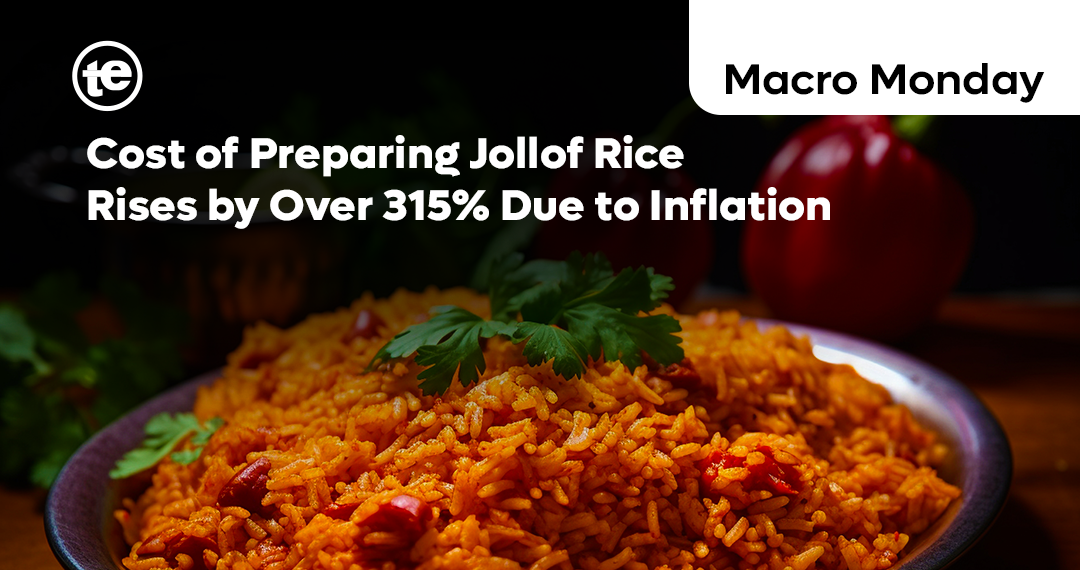Jollof rice, referred to by BBC as the “undisputed queen of West African kitchens,” continues to climb in price, but this isn’t discouraging fans from having it — no other food beats its mouth-watering taste.
The reason for the price increase isn’t far-fetched. Despite the minimum wage increase set to take place in January next year, the cost of jollof rice continues to hold on tight, climbing alongside it.
According to the SBM Jollof Index, the average cost of preparing a pot of jollof rice for a family of five has more than tripled within seven years, rising by 220.7% to ₦13,106 in September 2023.
Rewind to March 2021, the cost was ₦7,400 — 81% more than the ₦4,087 it cost in July 2016.
The sharp increase means a family earning the initial monthly minimum wage of N30,000 would have to spend 43.7% of their income on a single pot of Jollof rice. But anyway, the cost has continued to rise, nearly reaching ₦17,000 as of March 2024, with a 29.3% increase from October 2023.
The surge in jollof rice prices has had a ripple effect on the overall food inflation rate in Nigeria. Between October 2023 and March 2024, food inflation increased from 31.5% to 40.01%. The price of rice alone rose to a record high of ₦88,000 per bag in Lagos markets in February 2024.
The general inflation rate in Nigeria stood at 33.20% in the same month of March, hence, the inflation rate for a pot of jollof rice between July 2016 and March 2024 was 315.95%.
However, the recent rebound of the naira against the dollar made the price of a 50-kilogram bag of rice drop to an average of ₦67,000 in Lagos, Abuja, Ogun, and others, from almost ₦90,000 in February.
Many are left to wonder about the push behind these price accelerations, and of course, the reason is a combination of macroeconomic factors including inflation, changes in exchange rates, and fluctuations in the prices of key ingredients.
The main driver behind this price surge is the depreciation of the Nigerian naira, which has pushed up the cost of rice and other key ingredients such as turkey, beef, vegetable oil, and seasonings, among others.
The weakened naira and scarce foreign exchange (forex) have made imports more expensive, directly impacting the price of rice, one of the major ingredients in jollof rice.
Quite alright, tomatoes are seasonal and availability impacts the prices of Jollof rice but there seems to be a continuous acceleration in the price lately. A sum of the spices from onions and garlic to thyme and bay leaves, among other proteins influence this price hike.
Fuel Subsidies: Are They Helping the Poor or a Drain on the National Budget?
This brings us back to the price of rice and its fluctuations based on global supply and demand, weather conditions, and trade policies.
Countries that produce rice, such as Nigeria, Ghana, and Senegal influence the global supply. Droughts, floods, or changes in agricultural practices disrupt production, affecting prices.
Elevated transportation costs and supply chain disruptions have also contributed to the rising prices. The price of diesel, essential for food transportation, reached almost ₦1,500 per liter in late February and early March 2024.
The removal of fuel subsidies and the naira devaluation, implemented by the current administration, have further exacerbated the cost-of-living crisis facing many Nigerian households.
The impact of these macroeconomic factors varies across different regions of Nigeria. Residents of Onitsha in the South-East saw the highest increase in the cost of jollof rice at 44.9% between October 2023 and March 2024, while those in Nyanya, Abuja, experienced the slowest growth at 15.5%. Kano State recorded the highest cost of making jollof rice at ₦19,300 during this period.
The high cost of jollof rice has forced many Nigerians to make difficult choices. Some have resorted to using cheaper substitutes like soybean cheese (gbeske) in their stew, while others have cut down on protein intake by using smaller portions of meat or opting for dead chicken.
The situation has become so dire that many shop owners are closing down their businesses as they can no longer afford to operate.
Due to high inflation, currency devaluation, and supply chain disruptions, the humble jollof rice has become an emblem of the hardships endured by many Nigerian households.
Finding a Sustainable Path Forward
The solution to this could be a stable naira-dollar exchange rate, which is important for making imports more affordable. For local rice production, ensuring fuel availability at reasonable prices is essential for transporting ingredients and keeping food production costs down.
Added to these, a focus on domestic rice production through investments in farming infrastructure and technology can lessen reliance on imports and price fluctuations.
The implementation of these approaches will facilitate Nigeria’s maintenance of affordable jollof rice and ensure greater stability for its food system and economy.
Jollof Festivals: A Global Celebration
Despite the above challenges, Jollof still has its festivals that have become a global phenomenon, celebrating the dish and bringing food enthusiasts together worldwide.
The Jollof Festival UK is a day-long celebration of jollof rice, where chefs showcase their unique variations. Participants indulge in tastings, vote for their favorites, and enjoy themselves in West African culture.
Another is the Jollof Wars in the Twin Cities founded in 2017. This nationwide project celebrates jollof rice with participants tasting and voting for their favorite country’s version, facilitating friendly competition and cultural exchange.
Again, Knorr Jollof Fest in Nigeria is an exhilarating event where Nigerian food lovers savor their favorite dish. It brings renewed love for Jollof and highlights its economic impact on local communities.
Keep in mind that food inflation has been on the rise, and the price of rice has highly fluctuated in recent months. However, the strengthening of the naira in the past few weeks has coincided with a reduction in the price of rice in the market, providing some relief.






